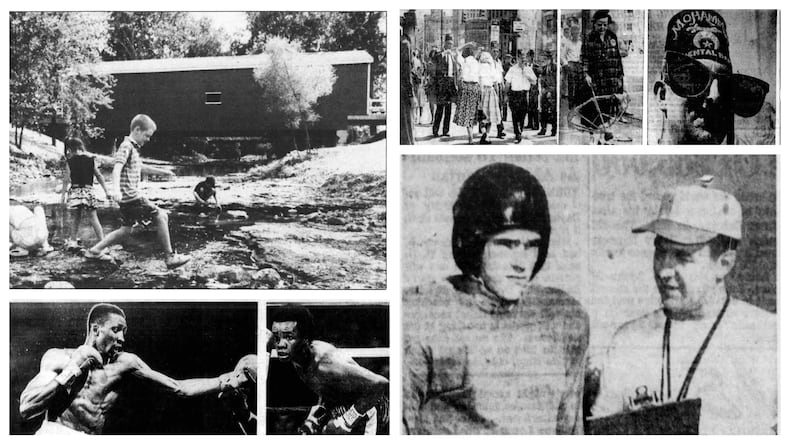Here’s a look at some stories from the week of Sept. 15-21.
Sept. 20, 1931: Ho, Hum! Now we have to learn this telephone business all over again
With the advent of the dial telephone system just six weeks away, Dayton telephone users were learning how to use the new receivers, hooks and dials of the new phones.
It was commonly agreed that learning new numbers was going to be the hardest part.
It was assumed that the 100,000 customers would have to memorize at least six new exchange numbers, the average amount believed one could hold in their mind.
All the old telephone buildings were to be abandoned and moved to a new location, a headquarters building at 215 W. Second St.
The numbers in new phone books were to be printed with the first two letters of the exchange name in capitals, as those two letters had to be dialed before the numbers themselves. Example: ADams2112.
45,000 subscribers had to be given individual numbers that hooked up properly on the exchange boards in their districts.
Pay stations were to have huge dials with the printing “outside of the part you twist.”
Sept. 19, 1951: 1st win in 3 years ups football picture at Oakwood
Just a few minutes before midnight more than 300 Oakwood high school football fans assembled at the school to salute the 1951 Lumberjacks, who had beaten Lebanon 24-12, in the first football game of the season for both teams.
It wasn’t just that Oakwood had beaten Lebanon, but that it marked the first Oakwood football victory since 1948.
Coach Ed Wysocki, a former all-Ohio running back at Miami, had high hopes for the future.
“We are in the midst of a big rebuilding program. It may take several years but just give us time and we’ll be back on our feet out here,” he said.
Oakwood’s first string quarterback was sophomore George Leupoid, who stood 5′2″ and weighed 118 pounds. He was also considered their best defensive player.
“He’s little, but he knows how to tackle, and despite his size, when he hits them they stay hit,” Wysocki said.
Sept. 17, 1961: Shriners parade plays to thousands
Daytonians turned out by the thousands in 1961 to see the most colorful parade they had seen in a long time.
Shriners marched, played music, rode, clowned and made noise for 2.3 miles after leaving Fourth and Main streets.
The parade lasted for the better part of two hours and included about 5,000 Shriners who were in town for a convention. Grownups and kids stood six people deep along the route. Many more watched from third and fourth floor windows.
Police had 50 officers assigned to the parade to keep order.
The parade route led to Welcome stadium for a Shrinearama. It included circus acts, the National Cash Register Co. band and a fireworks display.
Sept. 17, 1981: Hara Arena crowd just loved Leonard vs. Hearns fight
In 1981, the fight of the year was a highly anticipated matchup of Sugar Ray Leonard against Thomas “the hit man” Hearns. Dayton Daily News sports writer Si Burick was even sent to Las Vegas to cover the historic match.
In those days, pay-per-view television sporting events wasn’t a thing yet. The best you could do, aside from going to Las Vegas, was finding a “closed circuit colorcast.”
In Dayton, the place to see the fight was at Hara Arena, and nearly 2,000 fight fans paid to see the fight there.
The picture reproduction was reported to be clear and sharp, although the screen was seemingly smaller than previous closed circuit broadcasts.
After a long battle, Leonard was awarded a 14th round TKO over Hearns in the welterweight championship showdown. It was Hearns’ first loss in 33 professional fights.
Dayton Golden Glover Daryl Estes was at Hara for the fight.
“How can you take anything away from Leonard?” Estes said. “He was simply sensational. I never thought he could come back that way, he was so far behind in points. He was just amazing. And it was the greatest fight I’ve ever seen.”
Sept. 16, 1991: Preble’s historic Roberts Covered Bridge restored
The Roberts Covered Bridge in Preble County was damaged by arson in 1986. It took until 1991 to restore it.
A rededication ceremony was held to celebrate the accomplishment. About 300 people came to walk over the bridge and Seven-Mile Creek below it.
The then 162-year-old structure, (now 195 years), is the only historic double-barreled bridge in Ohio and the oldest two-lane covered bridge in the United States.
Fire destroyed the side of the bridge, but $40,000 in donations and the work of volunteers brought it back to life. A tax levy to restore the bridge failed to pass.
Richard Handley, who grew up a mile from the bridge, was pleased with the bridge’s appearance. He thought the bridge looked better than it did 80 years before, when he was a youngster playing hide-and-seek within its timbers.
About the Author






